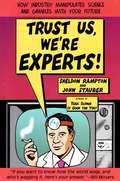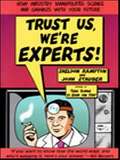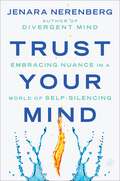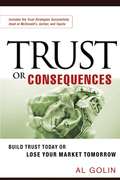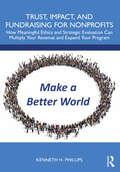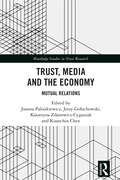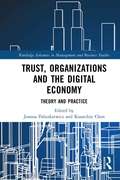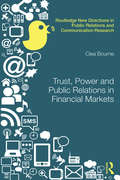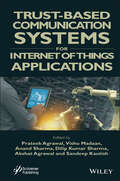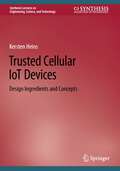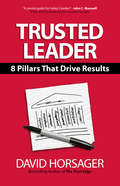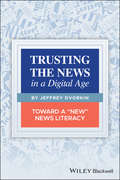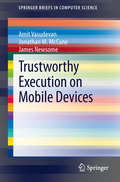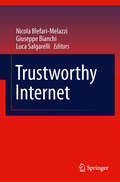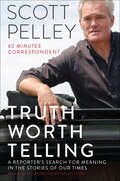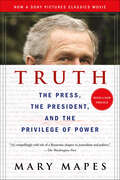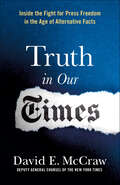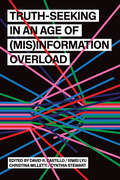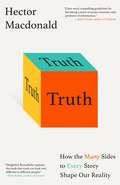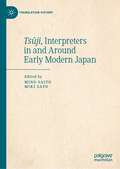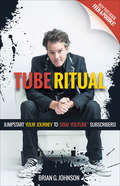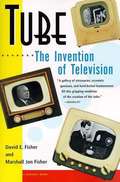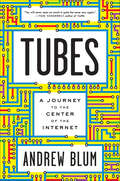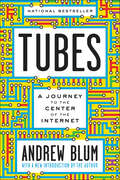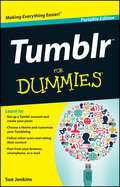- Table View
- List View
Trust Us, We're Experts
by Sheldon Rampton John StauberFearless investigative journalists Sheldon Rampton and John Stauber ( Toxic Sludge Is Good for You! and Mad Cow U.S.A.) are back with a gripping expos of the public relations industry and the scientists who back their business-funded, anti-consumer-safety agendas. There are two kinds of "experts" in question--the PR spin doctors behind the scenes and the "independent" experts paraded before the public, scientists who have been hand-selected, cultivated, and paid handsomely to promote the views of corporations involved in controversial actions. Lively writing on controversial topics such as dioxin, bovine growth hormone, and genetically modified food makes this a real page-turner, shocking in its portrayal of the real and potential dangers in each of these technological innovations and of the "media pseudo-environment" created to obfuscate the risks. By financing and publicizing views that support the goals of corporate sponsors, PR campaigns have, over the course of the century, managed to suppress the dangers of lead poisoning for decades, silence the scientist who discovered that rats fed on genetically modified corn had significant organ abnormalities, squelch television and newspaper stories about the risks of bovine growth hormone, and place enough confusion and doubt in the public's mind about global warming to suppress any mobilization for action. Rampton and Stauber introduce the movers and shakers of the PR industry, from the "risk communicators" (whose job is to downplay all risks) and "outrage managers" (with their four strategies--deflect, defer, dismiss, or defeat) to those who specialize in "public policy intelligence" (spying on opponents). Evidently, these elaborate PR campaigns are created for our own good. According to public relations philosophers, the public reacts emotionally to topics related to health and safety and is incapable of holding rational discourse. Needless to say, Rampton and Stauber find these views rather antidemocratic and intend to pull back the curtain to reveal the real wizard in Oz. This is one wake-up call that's hard to resist.
Trust Us, We're Experts PA: How Industry Manipulates Science and Gambles with Your Future
by Sheldon Rampton John StauberThe authors of Toxic Sludge Is Good for You! unmask the sneaky and widespread methods industry uses to influence opinion through bogus experts, doctored data, and manufactured facts. We count on the experts. <P><P>We count on them to tell us who to vote for, what to eat, how to raise our children. We watch them on TV, listen to them on the radio, read their opinions in magazine and newspaper articles and letters to the editor. We trust them to tell us what to think, because there's too much information out there and not enough hours in a day to sort it all out.We should stop trusting them right this second.
Trust Your Mind: Embracing Nuance in a World of Self-Silencing
by Jenara NerenbergAn urgent examination of self-silencing culture and the toxic impact of groupthink, by the author of Divergent Mind and founder of The Neurodiversity Project. Nerenberg empowers readers with tools to understand the mind and navigate an increasingly polarized world, from campuses and workplaces, to the media and beyond.Connected across geography and culture via the internet, the world is both a vast, limitless landscape and an ever-shrinking echo chamber. Communication, especially discourse over free speech, is becoming increasingly divisive; one person’s right to speak comes into conflict with another seeking to prevent harm. Our tolerance for differing opinions is also narrowing. A “wrong” remark or comment, no matter how seemingly innocent, can result in banishment, and contradictory ideas spark hysteria and backlash—what is referred to as “cancel culture.” This polarization affects everyone of us—among friends and families, workplaces and communities—and threatens the fabric of society.In this timely book, Jenara Nerenberg analyzes this phenomenon of “self-silencing,” asking potent questions about how harmful groupthink has become accepted. Applying her expertise in journalism, psychology, and public health, she digs deep into urgent problems that are worsening under a culture of self-censorship, including loneliness, isolation, and polarization.But there is hope. Nerenberg offers insights for how to identify and escape groupthink and transform fear into empathy, allowing space for authentic communication that reduces—rather than causes—harm to others.
Trust or Consequences: Build Trust Today or Lose Your Market Tomorrow
by Al GolinThe recent rash of corporate scandals--and the ensuing financial ruin of companies and their stockholders -- proves that even the bluest of blue chip businesses cannot bank on the blind faith of consumers and investors. <P><P>More than ever, corporations must rebuild, restore, and strengthen bonds of trust. Al Golin has helped create trust strategies for global business leaders including The Walt Disney Company, Hewlett-Packard, McDonald's, Toyota, Owens-Corning, and many others. Trust or Consequences shows what makes such strategies work, and reveals the eye-opening results of a survey of over 700 business professionals. This essential book reveals how to: * create an effective trust strategy * determine the impact of trust issues on stakeholders * assess trust-building performance and calculate the difficulty of restoring trust * create a ""trust bank"" for saving deposits of good will to draw on as needed Trust or Consequences offers tools for identifying trust opportunities, as well as numerous inside accounts of trust-building successes and failures by high-profile organizations and leaders. Filled with provocative ideas about why many companies overlook trust issues, Trust or Consequences brings the subject to center stage -- where it must remain if companies are to regain stakeholder loyalty and competitive advantage.
Trust, Impact, and Fundraising for Nonprofits: How meaningful ethics and strategic evaluation can multiply your revenue and expand your program
by Kenneth H. PhillipsDistilling decades of leadership expertise into an effective framework, this is a practical guidebook for nonprofits around the globe, with practical recommendations for the urgently needed steps to make this a better world. Charities in the United States and NGOs globally need to overcome two glaring and persistent weaknesses in the eyes of potential donors: trustworthiness and effectiveness. After examining possible causes for these deficits, fundraising and organizational development guru Ken Phillips guides readers through the process that leads to greater trust and respect by donors, better results for beneficiaries, significantly increased funding, and better and bigger programs. Alongside helpful worksheets, he presents seven steps to make sure ethics are meaningful, eight disciplines to ensure programs achieve good results, and a communications approach to demonstrate responsibility and accountability, all interwoven with inspiring case studies from his own international experience and other organizations’ stories. Staff and volunteers at registered nonprofits around the world, as well as any individual or group raising funds more informally, will value this guide to empower organizations to win trust, raise more funds, and achieve greater program impact.
Trust, Media and the Economy: Mutual Relations (Routledge Studies in Trust Research)
by Jerzy Gołuchowski Joanna Paliszkiewicz Kuanchin Chen Katarzyna Zdanowicz-CyganiakTrust, Media and the Economy: Mutual Relations delves into the critical relationships between trust, media, and economic behavior. This book explores how trust in media influences economic decisions and how economic conditions impact media trustworthiness. Divided into two parts, it first examines the role of trust within media channels, addressing topics such as the impact of clickbait, the role of user-generated content, and trust dynamics across generations. The second part focuses on how trusted communication affects economic outcomes, discussing social media’s role in economic communication, the influence of financial influencers, and trust-based marketing.The book features case studies from around the world, including Poland, France, and the United States, providing a broad geographical perspective. It includes topical issues such as the trust dynamics in YouTube communities and greenwashing practices. The contributors’ diverse expertise ensures a comprehensive analysis that is accessible to non-specialists, making it a valuable resource for booksellers, librarians, and general readers interested in media and economics. By shedding light on these interactions, the book offers groundbreaking insights into developing more reliable media practices and stronger economic trust foundations.
Trust, Organizations and the Digital Economy: Theory and Practice (Routledge Advances in Management and Business Studies)
by Joanna PaliszkiewiczTrust is a pervasive catalyst of human and business relationships that has inspired interest in researchers and practitioners alike. It has been shown to enhance engagement, communication, organizational performance, and online activities. Despite its role to cultivate cooperation, knowledge-sharing, and innovation, trust through digital means or even trust in digital media has presented new opportunities and challenges in society. Examples include a wider and faster dissemination of trust-influencing messages, and richer options of digital cues that engage, disrupt, or even transform how trust is formulated. Despite that, trust helps people to live through risky and uncertain situations, and the many capabilities enabled on the digital platforms have made the formation and sustaining of trust very different compared to traditional means. Trust in today’s digital environment plays an important role and is intertwined with concepts including reliability, quality, and privacy. This book aims to bring together the theory and practice of trust in the new digital era and will present theoretical and practical foundations. Trust is not given; we must work to build it, but it is a very fragile and intangible asset once built. It is easy to destroy and challenging to rebuild. Researchers, academics, and students in the fields of management, responsibility, and business ethics will gain knowledge on trust and related concepts, learn about the theoretical underpinnings of trust and how it sustains itself through digital dissemination, and explore empirically validated practice regarding trust and its related concepts.
Trust, Power and Public Relations in Financial Markets (Routledge New Directions in PR & Communication Research)
by Clea BourneThe public relations profession positions itself as expert in building trust throughout global markets, particularly after crisis strikes. Successive crises have tainted financial markets in recent years. Calls to restore trust in finance have been particularly pressing, given trust’s crucial role as lubricant in global financial engines. Nonetheless, years after the global financial crisis, trust in financial markets remains both tenuous and controversial. This book explores PR in financial markets, posing a fundamental question about PR professionals as would-be ‘trust strategists’. If PR promotes its expertise in building and restoring trust, how can it ignore its potential role in losing trust in the first place? Drawing on examples from state finance, international lending agencies, trade bodies, financial institutions and consumer groups in mature and emerging financial centres, this book explores the wide-ranging role of PR in financial markets, including: State finance and debt capital markets Investor relations, M&A and IPOs Corporate communications for financial institutions Product promotion and consumer finance Financial trade associations and lobbying Consumerism and financial activism. Far reaching and challenging, this innovative book will be essential reading for researchers, advanced students and professionals in PR, communication and finance.
Trust-Based Communication Systems for Internet of Things Applications
by Sandeep Kautish Anand Sharma Dilip Sharma Prateek Agrawal Vishu Madaan Akshat AgarwalTRUST-BASED COMMUNICATION SYSTEMS FOR INTERNET OF THINGS APPLICATIONS Highlighting the challenges and difficulties in implementing trust-based communication systems for Internet of Things (IoT) services and applications, this innovative new volume is a critical reference source for academics, professionals, engineers, technology designers, analysts, and students. The primary objective of this edited book is to deliver technologies to improve trust and eliminate malicious actors in participatory exchanges throughout communication using Internet of Things (IOT) devices such that these methods should not only be able to identify bad actors but also to improve communication and trust in the environment without violating object privacy. Whether as a reference for the engineer or scientist or a textbook for the student, this is a must-have for any library.
Trusted Cellular IoT Devices: Design Ingredients and Concepts (Synthesis Lectures on Engineering, Science, and Technology)
by Kersten HeinsThis book focuses on the impact of secure frontend devices for the Internet of Things (IoT). It explains how to identify vulnerabilities of IoT applications and how to protect them against misuse and attacks. Provided insights will help readers to design a reliable and trustworthy IoT ecosystem ensuring a high level of user confidence and a fruitful deployment. As a starting point, the book provides guidance how to identify risks and potential threats. Then, it explains which countermeasures are available and introduces all major ingredients for an efficient implementation of IoT security measures, e.g. a bullet-proof protection of user privacy and device identities. The author outlines an efficient design approach that combines classical embedded computing with smartcard technology and wireless cellular networking like LTE-M or NB-IoT. The target audience includes industrial professionals and students focusing on low cost design and a fast time-to-market. The book is ideal for engineering-minded IoT project owners to safeguard their business goals.
Trusted Leader: 8 Pillars That Drive Results
by David HorsagerWithout trust, people and businesses fail. Trusted Leader provides a framework for building trust so that you and your organizations can perform at your best."A lack of trust is your biggest expense," says Wall Street Journal bestselling author David Horsager. Without trust, transactions cannot occur. Without trust, influence is destroyed. Without trust, leaders lose their people. Trust can be either your most vulnerable weakness or your greatest asset. Horsager introduces readers to his Eight Pillars of Trust through the journey of a senior leader who thought success was certain. Follow CEO Ethan Parker as he discovers the power of trust and how to apply it amid the complexities of leadership, change, and culture transformation. The Eight Pillars of Trust (Clarity, Compassion, Character, Competency, Commitment, Connection, Contribution, and Consistency) are based on Horsager's original research and extensive experience working with Fortune 500 companies and top government agencies around the globe. In addition to the business parable, this book is rich in practical advice for implementing each of the Eight Pillars. You will learn strategies to increase alignment, overcome attrition, and get absolutely clear on executing your top priorities. Horsager offers a road map for how to become the most trusted expert in your industry.
Trusting the News in a Digital Age: Toward a "New" News Literacy
by Jeffrey DvorkinTRUSTING THE NEWS in a Digital Age How to use critical thinking to discern real news from fake newsTrusting the News in a Digital Age provides an ethical framework and the much-needed tools for assessing information produced in our digital age. With the tsunami of information on social media and other venues, many have come to distrust all forms of communication, including the news. This practical text offers guidance on how to use critical thinking, appropriate skepticism, and journalistic curiosity to handle this flow of undifferentiated information.Designed to encourage critical thinking, each chapter introduces specific content, followed at the end of each section with an ethical dilemma. The ideas presented are based on the author’s experiences as a teacher and public editor/ombudsman at NPR News. Trusting the News in a Digital Age prepares readers to deal with changes to news and information in the digital environment. It brings to light the fact that journalism is about treating the public as citizens first, and consumers of information second. This important text:Reveals how to use critical thinking to handle the never-ending flow of informationContains ethical dilemmas to help sharpen critical thinking skillsExplains how to verify sources and spot fraudsLooks at the economic and technological conditions that facilitated changes in communicationWritten for students of journalism and media studies, Trusting the News in the Digital Age offers guidance on how to hone critical thinking skills needed to discern fact from fiction.
Trustworthy Execution on Mobile Devices
by Amit Vasudevan James Newsome Jonathan M. MccuneThis brief considers the various stakeholders in today's mobile device ecosystem, and analyzes why widely-deployed hardware security primitives on mobile device platforms are inaccessible to application developers and end-users. Existing proposals are also evaluated for leveraging such primitives, and proves that they can indeed strengthen the security properties available to applications and users, without reducing the properties currently enjoyed by OEMs and network carriers. Finally, this brief makes recommendations for future research that may yield practical and deployable results.
Trustworthy Internet
by Nicola Blefari-Melazzi Giuseppe Bianchi Luca SalgarelliThis book collects a selection of the papers presented at the 21st International Tyrrhenian Workshop on Digital Communications, organized by CNIT and dedicated this year to the theme "Trustworthy Internet". The workshop provided a lively discussion on the challenges involved in reshaping the Internet into a trustworthy reality, articulated around the Internet by and for People, the Internet of Contents, the Internet of Services and the Internet of Things, supported by the Network Infrastructure foundation. The papers have been revised after the workshop to take account of feedbacks received by the audience. The book also includes: i) an introduction by the Editors, setting the scene and presenting evolution scenarios; ii) five papers written by the session chairmen, reputed scientists, and each dedicated to a facet of the trustworthy Internet vision; iii) a concluding paper, reporting the outcomes of a panel held at the conclusion of the workshop, written by the two keynote speakers.
Truth Worth Telling: A Reporter's Search for Meaning in the Stories of Our Times
by Scott PelleyThis inspiring memoir of life on the frontlines of history is a “riveting blend of investigative reporting, color commentary, and personal reminiscence” (Publishers Weekly, starred review).A 60 Minutes correspondent and former anchor of the CBS Evening News, Scott Pelley writes as a witness to events that changed our world. In moving, detailed prose, he stands with firefighters at the collapsing World Trade Center on 9/11, advances with American troops in combat in Afghanistan and Iraq, and reveals private moments with presidents (and would-be presidents) he’s known for decades. Pelley also offers a resounding defense of free speech and a free press as the rights that guarantee all others.Above all, Truth Worth Telling offers a collection of inspiring tales that reminds us of the importance of sticking to our values in uncertain times. For readers who believe that values matter, and that truth is worth telling, Pelley writes, “I have written this book for you.”
Truth and Duty: The Press, the President, and the Privilege of Power
by Mary MapesA riveting account of how the public's right to know is being attacked by an unholy alliance among politicians, news organizations and corporate AmericaTruth and Duty was made into the 2015 film Truth, starring Cate Blanchett, Robert Redford, Topher Grace and Elizabeth Moss. For twenty five years, Mary Mapes has been an award-winning television producer and reporter -- the last fifteen of them for CBS News, principally for the CBS Evening News with Dan Rather and 60 Minutes. She had the bedrock of respect of her peers -- in 2003 alone, she broke the story of the Abu Ghraib prison tortures (which won CBS The Peabody Award) and the existence of Strom Thurmond's illegitimate bi-racial daughter Essie Mae Washington. But it was Dan Rather's lightning rod of a story on George W. Bush's National Guard Service that brought Mapes into an unwanted limelight. The firestorm that followed the broadcast led not only to Mapes' firing and Rather's stepping down from his anchor chair a year early, but to an unprecedented "internal" inquiry into the story -- chaired by former Reagan Attorney General Richard Thornburgh.Peopled with an historic and colorful cast of characters—from Karl Rove to Summer Redstone to John Kerry to Col. Bobby Hodges -- this groundbreaking book about how the television news is made (and unmade) made headlines itself when first published. But this, it turns out, is only part of the story. Mapes talks for the first time about the riveting behind-the-scenes action at CBS during this frenzied period and exposes some of the largest political and social controversies that have broken in this new age of dissonance.
Truth in Our Times: Inside the Fight for Press Freedom in the Age of Alternative Facts
by David E. McCrawDavid E. McCraw recounts his experiences as the top newsroom lawyer for the New York Times during the most turbulent era for journalism in generations.In October 2016, when Donald Trump's lawyer demanded that The New York Times retract an article focused on two women that accused Trump of touching them inappropriately, David McCraw's scathing letter of refusal went viral and he became a hero of press freedom everywhere. But as you'll see in Truth in Our Times, for the top newsroom lawyer at the paper of record, it was just another day at the office.McCraw has worked at the Times since 2002, leading the paper's fight for freedom of information, defending it against libel suits, and providing legal counsel to the reporters breaking the biggest stories of the year. In short: if you've read a controversial story in the paper since the Bush administration, it went across his desk first. From Chelsea Manning's leaks to Trump's tax returns, McCraw is at the center of the paper's decisions about what news is fit to print.In Truth in Our Times, McCraw recounts the hard legal decisions behind the most impactful stories of the last decade with candor and style. The book is simultaneously a rare peek behind the curtain of the celebrated organization, a love letter to freedom of the press, and a decisive rebuttal of Trump's fake news slur through a series of hard cases. It is an absolute must-have for any dedicated reader of The New York Times.
Truth-Seeking in an Age of (SUNY series, Humanities to the Rescue)
by David R. Castillo, Siwei Lyu, Christina Milletti, and Cynthia StewartThe unprecedented spread of false and misleading information is the flip side of the Internet's promise of universal access and information democratization. This volume features original contributions from scholars working on the challenge of misinformation across a wide range of STEM, humanities, and art disciplines. Modeling a collaborative, multidisciplinary "convergence approach," Truth-Seeking in an Age of (Mis)Information Overload is structured in three parts. Part 1, "Misinformation and Artificial Intelligence," confronts the danger of outsourcing judgement and decision-making to AI instruments in key areas of public life, from the processing of loan applications to school funding, policing, and criminal sentencing. Part 2, "Science Communication," foregrounds the need to rethink how scientific findings are communicated to the public, calling on scientists to cooperate with colleagues in other disciplines and community representatives to help minimize the negative effects of mis/disinformation in such vital areas as climate change science and public health. Part 3, "Building Trust," further advocates for and explores instances of trust-building initiatives as a necessary precondition of both community-oriented scholarly activity and effective intervention strategies in high impact areas such as public health.
Truth: A User's Guide
by Hector Macdonald"In a time when truth is under assault, Hector Macdonald is here to defend it. He offers clear-eyed, compelling guidelines for becoming a more accurate consumer and producer of information."--Adam Grant, author of Give and Take, Originals, and Option B with Sheryl SandbergFor fans of Nudge, Sway, and The Art of Thinking Clearly, a fascinating dive into the many ways in which "competing truths" shape our opinions, behaviors, and beliefs.True or false? It's rarely that simple.There is more than one truth about most things. The Internet disseminates knowledge but it also spreads hatred. Eating meat is nutritious but it's also damaging to the environment. When we communicate we naturally select the truths that are most helpful to our agenda.We can select truths constructively to inspire organizations, encourage children, and drive progressive change. Or we can select truths that give a false impression of reality, misleading people without actually lying. Others can do the same, motivating or deceiving us with the truth. Truths are neutral but highly versatile tools that we can use for good or ill.In Truth: How the Many Sides to Every Story Shape Our Reality, Hector Macdonald explores how truth is used and abused in politics, business, the media and everyday life. He shows how a clearer understanding of truth's many faces renders us better able to navigate our world and more influential within it. Combining great storytelling with practical takeaways and a litany of fascinating, funny, and insightful case studies, Truth is a sobering and engaging read about how profoundly our mindsets and actions are influenced by the truths that those around us choose to tell.
Tsūji, Interpreters in and Around Early Modern Japan (Translation History)
by Mino Saito Miki SatoThis book introduces English-speaking audiences to tsūji, who were interpreters in different contexts in Japan and then the Ryukyu Kingdom from the late 16th to the mid-19th century. It comprises seven historical case studies on tsūji in which contributors adopt a context-oriented approach. They aim to explore the function of these interpreters in communication with other cultures in different languages, including Japanese, Dutch, Chinese, Korean, Ryukyuan, English, Russian and Ainu. Each chapter elucidates the tsūji and the surrounding social, political and economic conditions. The book will be of interest to students and scholars of translation and interpreting, but also readers interested in the early modern history of interpreting and cultural exchange. It will similarly appeal to those interested in the Japanese language, but with limited access to books written in Japanese.
Tube Ritual: Jumpstart Your Journey to 5000 YouTube Subscribers
by Brian G. JohnsonEverybody begins their YouTube journey from zero.You have to start with no videos, views, or subscribers. Furthermore, more than 400 minutes of content is uploaded to YouTube each minute. To say that it&’s challenging to grow a channel is an understatement! In fact, less than 3% of YouTube channels ever gain more than 10,000 subscribers. Yet, in a one-year period, Brian G Johnson gained 10,623 subscribers and drove over half a million video views. Truly beginning from zero. Brian had no previous YouTube success to draw from and had to learn the myriad of camera settings, editing options, and technical details that often become a roadblock. Furthermore, he did it in a small and competitive niche, the YouTube video marketing niche.How, you ask?By researching, testing, and tweaking various video growth methods over a one-year period in order to identify why the YouTube algorithm promotes one video over another. Ultimately, this led to the creation of a video ritual based on his findings—a series of actions according to a prescribed order. More than a mere guide, Tube Ritual is a one-year case study with the goal being to drive more views and convert more viewers into subscribers. For those already creating videos or who want to in the future, Tube Ritual contains detailed, step-by-step information that plain works. From Branding to thumbnails, video structure, YouTube SEO, video calls to action, playlist strategies, channel strategies and more, Tube Ritual leaves no stone unturned.
Tube: The Invention of Television
by Marshall Jon Fisher David E. FisherThe colorful, definitive story of the inventors of television, the race for patents, and the vicious courtroom battles for markets. You're on Jeopardy, the category is popular science, and the answer is "In 1927 he transmitted the first image via an all-electronic TV system." If you don't know the question, you're not alone. In the half century since its commercial unveiling, television has become the undisputed master of communications media, revolutionizing the way postwar generations have viewed the world. Yet few know how television was created, who created it, or how it actually works. Tube is a riveting tale of technological and commercial adventure. Here is the story not of one mad scientist working alone in a laboratory but of a group of brilliant minds—iconoclasts with motivations that ranged from the idealistic zeal of invention to pure greed, each keeping an eye on the others in the race for fortune and glory. Here, too, is the progress of an invention—from laboratory prototypes that drew public laughter to the legal warfare for control of what would become an enormous market power. With devilish character sketches, compelling stories, and engaging, accessible scientific explanations, authors David E. Fisher and Marshall Jon Fisher take us through the advent of "living color" and beyond, concluding with a glance to the future of the medium and the impact of recent digital technologies.
Tubes: A Journey to the Center of the Internet
by Andrew Blum“Andrew Blum plunges into the unseen but real ether of the Internet in a journey both compelling and profound….You will never open an email in quite the same way again.”—Tom Vanderbilt, New York Times bestselling author of TrafficWhen your Internet cable leaves your living room, where does it go? Almost everything about our day-to-day lives—and the broader scheme of human culture—can be found on the Internet. But what is it physically? And where is it really? Our mental map of the network is as blank as the map of the ocean that Columbus carried on his first Atlantic voyage. The Internet, its material nuts and bolts, is an unexplored territory. Until now.In Tubes, journalist Andrew Blum goes inside the Internet's physical infrastructure and flips on the lights, revealing an utterly fresh look at the online world we think we know. It is a shockingly tactile realm of unmarked compounds, populated by a special caste of engineer who pieces together our networks by hand; where glass fibers pulse with light and creaky telegraph buildings, tortuously rewired, become communication hubs once again. From the room in Los Angeles where the Internet first flickered to life to the caverns beneath Manhattan where new fiber-optic cable is buried; from the coast of Portugal, where a ten-thousand-mile undersea cable just two thumbs wide connects Europe and Africa, to the wilds of the Pacific Northwest, where Google, Microsoft, and Facebook have built monumental data centers—Blum chronicles the dramatic story of the Internet's development, explains how it all works, and takes the first-ever in-depth look inside its hidden monuments.This is a book about real places on the map: their sounds and smells, their storied pasts, their physical details, and the people who live there. For all the talk of the "placelessness" of our digital age, the Internet is as fixed in real, physical spaces as the railroad or telephone. You can map it and touch it, and you can visit it. Is the Internet in fact "a series of tubes" as Ted Stevens, the late senator from Alaska, once famously described it? How can we know the Internet's possibilities if we don't know its parts?Like Tracy Kidder's classic The Soul of a New Machine or Tom Vanderbilt's recent bestseller Traffic, Tubes combines on-the-ground reporting and lucid explanation into an engaging, mind-bending narrative to help us understand the physical world that underlies our digital lives.
Tubes: A Journey to the Center of the Internet
by Andrew BlumAn engaging, narrative tour behind the scenes of our everyday lives to see the dark beating heart of the Internet itself.We are all connected now. But connected to what, exactly? In Tubes, journalist Andrew Blum takes readers on a fascinating journey to find out.When former Senator Ted Stevens of Alaska famously described the Internet as “a series of tubes,” he seemed hopelessly, foolishly trapped in an old way of knowing the world. But he wasn’t wrong. After all, as Blum writes, the Internet exists: for all the talk of the “placelessness” of our digital age, the Internet is as fixed in real, physical places as any railroad or telephone ever was. It fills enormous buildings, converges in some places and avoids others, and it flows through tubes under ground, up in the air, and under the oceans all over the world. You can map it, you can smell it, and you can even visit it—and that’s just what Blum does in Tubes.From the room in Berkeley where the Internet flickered to life to the busiest streets in Manhattan as new fiber optic cable is laid down; from the coast of Portugal as a 10,000-mile undersea cable just two thumbs’ wide is laid down to connect Europe and West Africa to the wilds of the Pacific Northwest, where Google, Microsoft and Facebook have built monumental data centers—Blum visits them all to chronicle the dramatic story of the Internet’s development, explain how it all works, and capture the spirit of the place/Like Tracy Kidder’s classic The Soul of a New Machine or Tom Vanderbilt’s recent bestseller Traffic, Tubes combines deep reporting and lucid explanation into an engaging quest to understand the everyday world we live in.
Tumblr For Dummies
by Sue JenkinsCreate a Tumblelog and start posting--this fun, portable guide shows you howTumblr may be a microblogging platform, but there's nothing micro about it. There's no limit to what you can post in your blog--from text, photos, and links to audio, video, slideshows, and more. Now you can join the over 28 million Tumblelogs on Tumblr with this handy, portable guide. In the popular, For Dummies, easy-access style, this practical book shows you exactly what to do to get the most out of Tumblr. Set up your account, choose a theme, post from your computer or phone, see how to reblog content, and before you know it, you're off and Tumbling.Guides you in how to join and get the most out of Tumblr Shows you how to set up an account, choose a theme, customize your Tumblelog, and use the dashboard Explains how to follow other Tumblr users and reblog their content, and post from your browser, phone, or email Offers tips, trick, and techniques to make everything easyAll the detail you need to get up and running on this fun microblogging platform is here, in Tumblr For Dummies Portable Edition.
